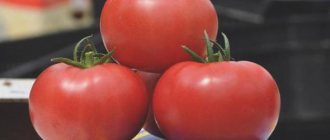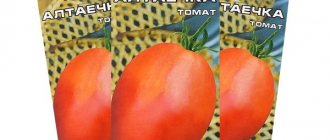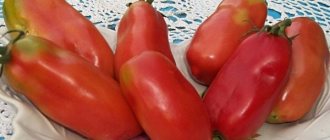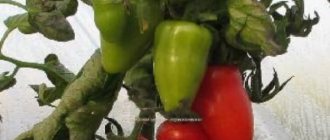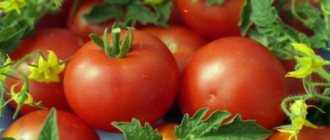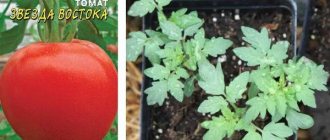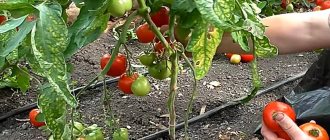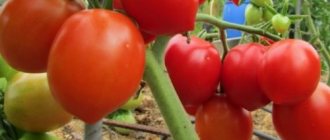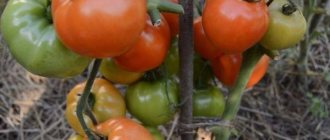Not all tomatoes are suitable for the harsh Siberian conditions, but all gardeners love to enjoy tomatoes. An excellent gift of selection was the hybrid Star of Siberia F1. Not only is it resistant to cold weather, but it also produces excellent yields.
| Height | Landing location | Ripening time | Fruit color | Fruit size | Origin | Fruit shape |
| Medium height | Greenhouse, Open ground | Mid-early | Reds | Average | Hybrid | Flat-round |
Features of cultivation, planting and care
Sowing seeds for seedlings is carried out 60-65 days before the intended planting in the ground.
Seedlings dive at the stage of two true leaves. When planting seedlings in a permanent place per 1 sq. It is recommended to place up to 4 plants per meter of land. Further care for tomatoes consists of timely watering, fertilizing with complex mineral fertilizer, pinching and preventive measures to protect against diseases and pests.
How to shape a tomato, video
If you grew Zvezda Siberia tomatoes, please write whether you liked them or not. What was the yield and taste of the fruits in your climatic conditions? Will you grow them again? Briefly describe the advantages and disadvantages of this tomato in your opinion. If possible, attach a photo of the entire bush or individual fruits you grew.
Read also: Let them talk on air yesterday
Your reviews of the Star of Siberia tomato and additions to the description will help many gardeners evaluate this hybrid more objectively and decide whether it is worth growing or not.
The Star of Siberia tomato belongs to the first generation hybrids. The variety is distinguished by ease of care, abundant fruiting, and the taste of ripe fruits.
Agricultural cultivation technology
The hybrid Star of Siberia is a resistant variety that can bear fruit in dry and rainy seasons. Its cultivation is no different from similar tomatoes. In order to remove ripe fruits from the bush earlier, seeds are sown 60-65 days before the expected date of planting in the ground.
Read also: Khachapuri in Adjarian food ru
The “Star of Siberia” tomato can attract attention by its very name, which it received due to the results when grown in the Siberian climate. Minimal care, good yield, fruits with rich taste - these are the main features that will attract any gardener.
Characteristic
No matter how strange it may seem, the most favorable conditions for high yield of the variety, according to the results of numerous studies and practice, are the conditions of the harsh climate of Siberia, where this unusual, impressive and non-standard name came from. Tomatoes of this variety are a determinate plant, sometimes reaching one and a half meters in height. Therefore, “Star of Siberia” is classified as a medium-sized tomato.
Due to its agility and medium growth, the plant must be tied to supports, otherwise the stem may break and lead to the death of the tomato. As the plant grows, we must not forget about shaping the bushes; we also need to remove excess leaves from time to time.
The fruits of this variety of tomatoes are usually very large, have a standard round shape, are juicy, and have a lot of pulp. Ripe vegetables have a red, rich color. The pulp of the fruit is fleshy, has a pleasant aroma and sweet taste, thanks to which it can be used for various purposes. The weight of one tomato of the “Star of Siberia” variety can reach 200 grams, which is quite a lot.
Characteristics of the variety
As practice has shown, the best results of growing the specified tomato were obtained in the Siberian climate. This tomato owes its non-standard name.
In addition to excellent taste, the fruits are distinguished by the presence of a huge amount of nutrients and microelements. In particular, tomatoes contain vitamin E, which is a natural antioxidant.
The characteristics and description of this determinate variety allow us to say that the bushes reach a height of 1.4 meters. According to this indicator, the plant is classified as medium-sized. Since it is very spreading, it requires a mandatory garter. You will need to mold the bush and remove excess leaves.
The description of the variety suggests that the fruits of Star of Siberia F1 at maturity are distinguished by a rich red color, large size, round shape and the presence of slight ribbing. The weight of one tomato is up to 200 grams. The pulp is quite juicy, very fleshy, dense, and has a pleasant aroma.
The taste of tomato is sweetish. The productivity is very high, one bush can produce up to 5 kilograms of ripe and high-quality fruits. The harvested crop is consumed both fresh, canned and processed.
Tomatoes of Siberian selection
Growing high-quality and tasty tomatoes in cold climates is a real art.
In addition to the various secrets and techniques of the masters of this business, it is important to know the “right” varieties. Not all common tomato varieties are suitable for the Siberian climate
In this article we will look at Siberian varieties of tomatoes that have proven themselves and become popular among gardeners.
Tomatoes of Siberian selection for greenhouses
All varieties of tomatoes for Siberia are grown exclusively through seedlings. Greenhouses are most often used, since planting in open ground is accompanied by a lot of difficulties that only experienced gardeners can overcome. Here is a list of tomatoes of Siberian selection for greenhouses:
- Scarlet candles (a tall variety, characterized by a very high percentage of hearth tying, requiring mandatory pinching and gartering);
- Yellow icicle (among the Siberian tomato varieties bred for greenhouse cultivation, this one is characterized by increased resistance to late blight, the fruits are bright yellow, suitable for pickling or salads);
- Chanterelle (refers to varieties of tomatoes of Siberian selection, which are suitable for canning; the fruits are sweet and covered with thick skin);
- Sabelka (the fruits have almost no seeds, are very fleshy and dense, suitable for canning, the variety is mid-fruiting and late-ripening);
- King of Siberia (one of the large-fruited tomatoes of Siberian selection, the fruits are bright yellow, weighing up to 1 kg, the skin is thin, and the flesh is fleshy and sweet).
Siberian varieties of open ground tomatoes
For gardeners who have already learned the intricacies of growing in open ground, it is worth paying attention to the following varieties:
- Nikola (one of the best Siberian tomato varieties for growing in open ground, relatively large hearths, bright red color, low-growing bush);
- Tsar Bell (has proven itself due to its high resistance to diseases and typical weather conditions, the fruits have excellent taste, are fleshy and sweet);
- Cherry Blosem F1 (are among the best varieties of tomatoes of Siberian selection, as they are equally successfully grown in open ground and greenhouse conditions, the fruits are very sweet and do not crack as they ripen, the bushes are not susceptible to diseases, it is better to eat the fruits fresh).
New varieties of tomatoes from Siberian selection
Although some varieties have already become legends and gardeners try again and again to get a bountiful harvest, breeders do not sit still. Every year, new Siberian-bred tomatoes appear that have more advanced qualities and the ability to withstand external factors. Among the relatively new tomato varieties of Siberian selection, the following are considered successful:
- Eagle's Beak (can be grown both in greenhouse conditions and in open ground; the fruits are excellent for pickling, a medium-ripening variety);
- Olesya (recommended for greenhouses, the fruits are very tasty, bright orange, intended for pickling);
- Shalun (belongs to the early tomatoes of Siberian selection, the pods are sweet and have an unusual decorative shape, a variety with very high yield);
- Greek F1 (this is an early ripening hybrid, recommended for greenhouse cultivation, oblong hearths with a spout, excellent taste, suitable for salads or pickling).
Almost all varieties are highly resistant to pest attack, the fruits are sweet and many of them are intended for pickling. Almost all of them are unpretentious in care and produce a good quality harvest.
womanadvice.ru
Growing seedlings
There are no particular differences in breeding “Pride of Siberia”. Like others
tomatoes
, this species is grown using seedlings.
Good seedlings are selected according to external data:
- Young bushes must be alive (not withered). Seedlings for sale should be displayed in containers with substrate, and not in bags.
- The length of the bushes should not exceed 30 cm. Inspect each plant so that there are about 8 true leaves on the trunk.
- The age of the bushes should not exceed 45–60 days.
- The trunks should be thick, and the roots should be well developed and without noticeable damage.
- All leaves should be green, but it should not be too rich in color. If the bright green leaves are also curled inward, this indicates that an accelerated growing method was used (the seedlings were fed with copious amounts of nitrogen fertilizer).
- Inspect sheet plastic for the presence of Colorado potato beetle eggs. There should not be any dark spots on the stem. Distorted and wrinkled leaves may indicate that the bushes are damaged by infectious diseases.
The Siberian selection tomato is a heat-loving plant. The optimal temperature for breeding is 18–25 °C. In addition to heat, plants must be provided with good lighting. Grow tomatoes in
greenhouse
LED energy-saving phytolamps allow. As for air humidity, the ideal figure is 60–70%.
Tomatoes prefer loose, warm and nutritious soil. The bushes respond positively to soil rich in nitrogen and potassium. It would be a good idea to disinfect the soil by soaking it in potassium permanganate or copper sulfate solution. In addition, tomatoes love slightly alkaline soil: a comfortable reaction is 6.5–7.0 pH (a little higher is acceptable).
Seeds are usually sown in March; before this, containers for seedlings and fertile soil, made independently or purchased in a store, must be prepared. Before planting, seeds are disinfected in potassium permanganate or hot water. Some experienced gardeners recommend germinating the seeds before planting by wrapping them in a damp cloth.
When the preparatory work is completed, furrows are made in the soil, and the seeds are laid out in them, keeping an interval of 2 cm. Then they are sprinkled with soil and moistened, and the container is covered with film and placed in a warm place. Until the sprouts hatch, the seedlings are ventilated and watered every day. After the shoots have appeared, the shelter is removed and the container is transferred to a sunny and warm windowsill.
When two leaves appear, the seedlings need to be picked into a separate container; plastic glasses and cut-off bottles with a volume of at least 500 ml are suitable. 2 weeks after transplantation, the seedlings can be fed. Complex fertilizers for seedlings are perfect for this. Approximately 50 days after sowing, young plants can begin to be hardened, this will help them quickly adapt to a new place during the upcoming transplant.
Mini tomatoes
Although all the presented varieties belong to the same species, there are still differences in care and cultivation.
Siberian date
Mid-season hybrid, standard size. The name characterizes the small size of the fruit, as well as their weight, which is about 30 g
A distinctive feature is the ability to remain fresh for a long time.
Bulls-eye
Data slightly above average, up to 2 m in height. Smooth round tomatoes, very light weight, only 30 g. Often used as an ornamental variety due to their small size.
It tastes very sweet.
Countryman
Prefers open ground. There is probably no variety that was easier to care for than this one. Weight is small, up to 80 g.
At the same time, the yield percentage is very high, up to 4 kilograms per bush.
Gardening is, in principle, a relaxing and profitable leisure activity. If you do everything correctly, you can consider this a second job; fresh vegetables, especially in the cold season, are in great demand.
Siberian gardeners are lucky in this regard, with a short summer and species specially bred for these places. They are distinguished by excellent taste, in no way inferior to the species growing in the warm regions of our vast Motherland. It is also immune to almost all types of diseases to which tomatoes are susceptible. They are completely unpretentious to growing conditions, which is a huge plus.
As has already become clear, tomato seeds of Siberian selection are the most productive in conditions of short summer and temperature variability. Another advantage is the huge range of varieties of this species, which allows each gardener to choose an individual variety. There are both large “giants” and small tomatoes. Everyone’s taste is completely different, each of them has excellent uses in gastronomy.
Description:
- Sugary with tender pulp
- Great scent
- up to 450 g
Delicate sugary pulp with a wonderful aroma, up to 1 kg. An early ripening variety for growing in film greenhouses. The period from germination to the beginning of ripening is 95-110 days. The plant is tall, up to 200 cm, and requires staking and shaping. The fruits are fleshy, large, heart-shaped, smooth or slightly ribbed, average weight 300-450 g (the first ones up to 1 kg). The color of the ripe fruit is pink-crimson with a small yellowish spot at the stalk. The taste is excellent, the flesh is juicy, aromatic, the skin is tender. For fresh consumption, making juices and a variety of tomato products.
Recommendations for cultivation
The variety is resistant. Productivity even in difficult climates. Does not differ in cultivation from similar hybrid varieties. Sowing seedlings should be carried out 2 months before planting in the ground, in March - April to a depth of 1 -2 cm. Planting seedlings in greenhouse conditions is desirable in April - May, in the ground - in June. Planting according to the 40x60 pattern. It begins to bear fruit in 110–120 days.
In addition to interesting varieties of tomatoes, Siberia is famous for its very tasty fish. I recently came across an interesting website and ordered the most delicious smoked fish of my life in Surgut. I advise everyone, the order will be completed in 2 days. There are a lot of types of fish, you can buy whatever you want.
- A garter is needed to keep the tomatoes from touching the ground.
- Periodic fertilizing is required to improve the yield and taste of the fruit.
- Do not feed when the ovary is forming.
- At the beginning of growth, shoot and remove old leaves, leaving 3 - 4 branches.
- Watering after the soil dries out.
Nina: As a very busy dacha resident, I didn’t show up at the dacha every day. This is not the first time I have planted this variety. Due to the climatic characteristics of our area, I do such manipulations. Tomatoes planted in the ground were covered with agrotex for the first couple of weeks to protect them from sudden temperature changes. After heavy rain, I shook off the water from the bushes so as not to get late blight. I cut off the tops and plucked off flower clusters that did not set fruit. And in due time I received 3 kg of delicious tomatoes from the bush.
Irina: For the first time I planted a star of Siberia and was surprised at its unpretentiousness. Planted it in a greenhouse. She always fed me. I used phosphorus-potassium fertilizers to improve fruit set. I also used organic ones a couple of times during the season. I use drip irrigation in the greenhouse and loosen the soil the next day. As a result, I got delicious tomatoes that survived the long journey to the city. Not a single fruit was crushed. It made us happy for a long time, both in salads and in a jar in winter.
Tomato “star of Siberia”: characteristics, description and features - all about tomatoes
Not all tomatoes are suitable for the harsh Siberian conditions, but all gardeners love to enjoy tomatoes. An excellent gift of selection was the hybrid Star of Siberia F1. Not only is it resistant to cold weather, but it also produces excellent yields.
| Height | Landing location | Ripening time | Fruit color | Fruit size | Origin | Fruit shape |
| Medium height | Greenhouse, Open ground | Mid-early | Reds | Average | Hybrid | Flat-round |
The best long-bearing tomato seeds
"BATYANYA " is a popular representative of large-fruited tall tomatoes. The plant reaches a height of up to 2 m, it must be formed into 1-2 stems, with a mandatory garter to the trellis.
Early ripening, from germination to the beginning of ripening 90-95 days.
High-yielding (up to 17 kg/m2), with excellent taste. The fruits weigh 200-350 g, pink-raspberry color, sugar, smooth, fleshy, heart-shaped with a spout.
“DE BARAO TSARSKY” is a medium-late variety, for open ground and greenhouses, the growing season is 120-130 days. Cold-resistant, shade-tolerant, resistant to late blight.
The plant is powerful, tall (up to 3 m). Stems are powerful, medium leafy. The fruits are elongated, with an average weight of 150 grams. About 10 clusters can form on one bush, each of which can grow up to 7 fruits. Productivity can reach up to 12 kg per bush.
Used fresh, for canning and pickling. Ripe fruits can be stored for a long time.
“KORNEEVSKY” - mid-season, medium-sized (up to 1 m).
Plants feel comfortable in greenhouse conditions in the northern region.
The value of the variety lies in the high shelf life of the fruit and good transportability. They are stored for a long time.
The variety is resistant to cracking, as well as diseases and pests. The fruits are fleshy, sweet, flat-round, pink in color, weighing up to 800 g.
Early low-growing tomatoes of Siberian selection for open ground
We, living in a region with cool and short summers, appreciated the tomato hybrids bred by Siberian breeders for open ground.
their value lies in the fact that they are insensitive to temperature changes, resistant to cold, high-yielding and able to ripen after being picked from the bush.
Tomatoes of Siberian selection are suitable for the Urals and central Russia, for areas of risky farming.
The best tomatoes of Siberian selection:
Early, mid-early, low-growing, super-yielding, ultra-early ripening up to (80 days from germination to fruiting), many varieties do not require pinching.
Among them are excellent pickling tomato varieties:
Of course, this is not a complete list of the best varieties of tomatoes of Siberian selection.
Tomatoes are determinate and indeterminate, what is the difference?
Determinate tomatoes - low-growing varieties with limited growth, from 60 cm to 1 m
According to classification, they can be divided into subspecies:
- semi-determinant - stop growing after the formation of 10-12 brushes,
- superderminant - stop growing after the formation of the third brush. Stem height is 30 to 60 cm, does not require gartering or pinching.
Indeterminate (unlimited growth) - the tallest, stem growth is unlimited (from 2 m and above). For a good harvest, timely pinching, installation of supports and gartering are necessary. In risky farming areas, greenhouse cultivation is recommended.
The difference between these varieties is clearly shown in this video. Have a nice watching.
We could stop there, but I really want to share some more information. I think it will be useful to you.
The most productive fleshy tomatoes: Bull's heart, Fleshy truffle, Katyusha, Titan, Morozko, Ox's heart, Classic, Skif, Altai orange, Budenovka, Krasavets and Sugar fleshy, Orange, Chelyabinsk meteorite F1, Leo Tolstoy, Altai red.
And these are typical low-growing tomatoes for the Urals:
The highest and super-yielding tomatoes will be especially interesting for you:
King of the Giants, Sunny Bunny, Money Bag, Djalo Manta, Red Arrow, Vermilion, cherry St. F1, O-la-la, Currency, Monomakh's Hat, Linda F1, Kemerovo, Hospitable, Pink Stella, Fidelio, Shady-Lady F1, Fidget , Em-Champion...
Source: https://tomatbolshevat.ru/drugoe/tomat-zvezda-sibiri-harakteristika-opisanie-i-osobennosti-vse-o-pomidorkah.html
Characteristics of the variety
As practice has shown, the best results of growing the specified tomato were obtained in the Siberian climate. This tomato owes its non-standard name.
In addition to excellent taste, the fruits are distinguished by the presence of a huge amount of nutrients and microelements. In particular, tomatoes contain vitamin E, which is a natural antioxidant.
The characteristics and description of this determinate variety allow us to say that the bushes reach a height of 1.4 meters. According to this indicator, the plant is classified as medium-sized. Since it is very spreading, it requires a mandatory garter. You will need to mold the bush and remove excess leaves.
The description of the variety suggests that the fruits of Star of Siberia F1 at maturity are distinguished by a rich red color, large size, round shape and the presence of slight ribbing. The weight of one tomato is up to 200 grams. The pulp is quite juicy, very fleshy, dense, and has a pleasant aroma.
The taste of tomato is sweetish. The productivity is very high, one bush can produce up to 5 kilograms of ripe and high-quality fruits. The harvested crop is consumed both fresh, canned and processed.
Features of cultivation
The tomato variety Zvezda Siberia is very resistant and can produce crops both in dry conditions and in rainy and damp summers. Its cultivation is no different from similar hybrid varieties. To get the first fruits as early as possible, seedlings should be sown 2 months before the intended planting in the ground.
The hybrid can be grown not only in open ground, but also in a greenhouse. There are some cultivation features.
The tomato should be tied up and not allowed to touch the ground. Tomatoes require periodic feeding, which not only increases yield, but also improves the taste of the fruit.
If there is a lack of nutrition in the soil, it will not be possible to obtain the maximum number of fruits, but moderate fertilizing will contribute to this. When the ovary is forming, plants should not be fed so that they do not begin to actively grow green mass.
Characteristics of the tomato Star of Siberia f1, advantages of the hybrid and agricultural cultivation techniques
The “Star of Siberia” tomato can attract attention by its very name, which it received due to the results when grown in the Siberian climate. Minimal care, good yield, fruits with rich taste - these are the main features that will attract any gardener.
Recommendations for cultivation
The variety is resistant. Productivity even in difficult climates. Does not differ in cultivation from similar hybrid varieties. Sowing seedlings should be carried out 2 months before planting in the ground, in March - April to a depth of 1 -2 cm. Planting seedlings in greenhouse conditions is desirable in April - May, in the ground - in June. Planting according to the 40x60 pattern. It begins to bear fruit in 110–120 days.
- A garter is needed to keep the tomatoes from touching the ground.
- Periodic fertilizing is required to improve the yield and taste of the fruit.
- Do not feed when the ovary is forming.
- At the beginning of growth, shoot and remove old leaves, leaving 3 - 4 branches.
- Watering after the soil dries out.
If you grew Zvezda Siberia tomatoes, please write whether you liked them or not. What was the yield and taste of the fruits in your climatic conditions? Will you grow them again? Briefly describe the advantages and disadvantages of this tomato in your opinion. If possible, attach a photo of the entire bush or individual fruits you grew.
Your reviews of the Star of Siberia tomato and additions to the description will help many gardeners evaluate this hybrid more objectively and decide whether it is worth growing or not.
Characteristics of tomato
The “Star of Siberia” tomato is distinguished by its high yield and relatively high early maturity, even in a cool and humid environment. The ripening period lasts on average 110-115 days.
Suitable for growing in a wide variety of conditions and bears fruit equally well in both wet and dry summers, without requiring complex care. In addition to high endurance, “Star of Siberia” has phenomenal productivity - up to 5 kg of tomatoes can be harvested from one bush.
Tomato Star of Siberia
photo author Galina Korolenko
Description and characteristics of tomato Star of Siberia F1, reviews, photos
Mid-season (110-115 days from germination to the beginning of ripening), medium-sized, unpretentious, productive tomato hybrid for greenhouses and open ground. Developed for central Russia, where summers are short and unpredictable. The hybrid sets fruit well in any summer.
The bush is 1-1.4 meters high and requires tying to a support and pinching. The best results were obtained when forming a plant with 3 or 4 stems.
Basic qualities of fruits
The fruits are round, dense, red in color at maturity, weighing 150-200 grams, fleshy, good taste (for a hybrid). These tomatoes are good for salads and all types of processing into tomato products, canning.
To use fruits for salads, let them ripen on the bush - the taste in this case is noticeably better.
Seed producer : agricultural company Gavrish.
Features of cultivation, planting and care
Sowing seeds for seedlings is carried out 60-65 days before the intended planting in the ground. Seedlings dive at the stage of two true leaves. When planting seedlings in a permanent place per 1 sq. It is recommended to place up to 4 plants per meter of land.
Further care for tomatoes consists of timely watering, fertilizing with complex mineral fertilizer, pinching and preventive measures to protect against diseases and pests.
When growing tomatoes in a greenhouse, we recommend installing a drip irrigation system - this will save your time and effort, as well as increase plant productivity and reduce the risk of late blight.
Delivery time
Delivery time is agreed upon with the manager, who will contact you immediately after you place your order.*Attention! An incorrect telephone number, inaccurate or incomplete address may result in additional delays! Please check your personal information carefully when registering and placing an order. The confidentiality of your registration data is guaranteed. *Orders placed on Saturday and Sunday are processed only on Monday. *Delivery time depends on the time the order is placed and the availability of goods in stock. *Delivery to the transport company is carried out within 3 business days
The confidentiality of your registration data is guaranteed. *Orders placed on Saturday and Sunday are processed only on Monday. *Delivery time depends on the time the order is placed and the availability of goods in stock. *Delivery to the transport company is carried out within 3 business days
Description of the variety
The Star of Siberia tomato fits the description of a hybrid tomato variety. The best harvest can be obtained in the climate of Siberia and the Urals, hence its unusual name. In addition to its excellent taste, this variety is distinguished by a large amount of vitamins and minerals; a distinctive feature is the increased content of vitamin E, a natural antioxidant.
Bushes
Since the plant is determinant, the height of the bush is limited to 1.4 m. The bush is medium-sized, spreading, requiring garter. As a rule, the plant has one trunk and numerous shoots covered with leaves, which are removed when the bush is formed.
For growing in harsh climatic conditions, it is also recommended to choose the varieties Siberian early ripening, Cherry, Bull's heart, Gina, Chelnok, Dubok.
Fruit
Ripe fruits of this variety are red, large, which is typical for a hybrid (can weigh up to 200 g), round in shape, slightly ribbed. The pulp is juicy, fleshy and aromatic, has a sweetish taste. The fruits are quite dense, so Star of Siberia tomatoes are actively used for canning.
Features of cultivation
The preparation and cultivation of “Star of Siberia” tomatoes does not differ significantly from the cultivation of other hybrid varieties. Approximately 60-65 days before planting, it is necessary to sow the seeds for seedlings.
Since the plant is a medium-sized plant, it can easily be planted not only in the ground, but also in a greenhouse. The timing of planting seedlings in a greenhouse and in the ground is somewhat different - they are planted in a greenhouse earlier, in April-May, and in the ground - no earlier than June.
Important! Before planting seeds for seedlings, it is recommended to germinate them, this will speed up the germination of plants. tomatoes
- Since the bushes can reach a height of 1.4 m, staking the bushes to stakes is a must when planting.
- Another important point is to fertilize tomatoes regularly to increase yield and improve the taste of tomatoes.
- After planting in the ground, the plant is subject to pinching (removing new shoots); at your discretion, you can leave 1-2 shoots.
Did you know? Experienced gardeners have noticed that bushes with 3-4 branches show the best yield.
Resistance to diseases and adverse conditions
Since this is a greenhouse variety of tomatoes, it is immediately protected from a number of unfavorable external factors, for example, from bad weather or excessively scorching sun. But we should not forget that there are many different diseases in the soil that can cause various diseases of tomatoes. So, some of the most common diseases are:
- Late blight.
- Gray rot.
- Brown spot.
- Root rot.
- Apical rot, etc.
They manifest themselves as follows: the leaves curl, their color fades, the fruits can either dry out or become covered with brown spots, in some cases the fruits are obtained without seeds at all.
If these signs are detected, you should not resort to the use of chemicals - the bush cannot be saved, since many tomato diseases are classified as fungal diseases that multiply quickly. It is necessary to remove the bush and treat the soil, or better yet, replace it with new soil.
Therefore, when growing almost any variety of greenhouse tomatoes, you should be very careful so that when these “illnesses” first appear, they are eliminated.
Characteristics and description of the variety
However, the tomato of the same name is positioned as determinate, with a height of up to 150 cm.
In any case, the plant needs to be tied up and formed into 1 or 2 stems. The fruits begin to ripen 110-120 days after sowing.
External description
The fruits are very tasty fresh. They can be eaten plain as a snack or used in slices and salads. They are not suitable for preservation due to their large size, and they do not contain enough liquid for making juice.
Productivity
On average, 5-6 kg of tomatoes are harvested from one bush. Productivity in greenhouses is an order of magnitude higher than in open ground. In addition, to improve performance, single-stem formation and additional fertilizing are used.
Sustainability
According to its characteristics, tomato resistance to cold is high: the King of Siberia variety calmly tolerates sudden weather changes and is rarely affected by late blight, tobacco mosaic and other fungal diseases.
However, insect pests pose a potential risk that requires preventative measures to reduce.
Tomatoes have a very pleasant taste, sweet. The sugar content is higher than that of other varieties of tomatoes.
The variety “King of Siberia” has high yield. Subject to agrotechnical recommendations, up to 5 kg of tomatoes are harvested from each bush, and up to 15 kg of tomatoes from 1 m².
Seeds of the “King of Siberia” are found on sale under various trademarks sold by well-known agricultural companies:
- Seeds of Altai offers indeterminate tomatoes with regular-shaped leaves and large yellow fruits.
- "Aelita" produces the seeds of a tall plant with large leaves and heart-shaped yellow-orange fruits.
- “Siberian Garden” offers gardeners a determinate variety of tomatoes up to 150 cm high, with regular leaves and very large orange fruits.
Similar varieties
Other tomato varieties that are suitable for northern conditions and have similar characteristics include:
- "Ultra early ripening"
- "Siberian heavyweight"
- "Demidov"
- "Abakan pink"
- "Alsu"
- "Siberian early ripening."
The characteristics and description of a tomato, such as the giant tomato variety King of Siberia, consists of several points.
- The King of Siberia is distinguished by its high yield.
- With proper agricultural technology, the time from germination to the first harvest is about 125 days.
- When forming, it is advisable to leave no more than two stems.
- The standard type, the King of Siberia tomato, is intended for cultivation in cold climates and in more southern regions.
- The variety is resistant to many diseases.
Let’s take the King of Siberia tomato and begin its description with the characteristics of the bush. The tomato bush is quite strong, but has few leaves. The stems bear leaves similar to maple leaves. At a height of up to 1.5 m, the first clusters appear at the 5th internode level. The raceme is loose and bears up to 10 flowers. Flowering is abundant and simultaneous.
After setting the fruit, it is even necessary to secure the fruit clusters themselves with ties. This is done so that the heavy weight of the fruit does not break the stems. Each tomato, when ripe, is light green in color. As they grow and ripen, the fruits turn yellow and weigh up to 700g each.
The fruiting chambers are small, but there are enough seeds in each of them to collect seed. The pulp of the fruit is sugary, tasty, and may have an orange color. This shade is determined by the presence of beta-carotene in the fruits.
| Height | Landing location | Ripening time | Fruit color | Fruit size | Origin | Fruit shape |
| Tall | Greenhouse, Open ground | Mid-season | Yellow | Large | Variety | Heart-shaped |
The pulp is very tasty, sweet and juicy. It is better to use the variety for salads and fresh consumption, but you can add tomatoes to dishes or make beautiful juices and sauces.
We invite you to familiarize yourself with the Description of the Goldilocks tomato variety and its characteristics
Data about the breeder who received this tomato as a result of his work are contradictory. The lack of information in the Register leads to the fact that data on the characteristics of this tomato variety are insignificant. The supposed author of the variety is Vladimir Dederko. After being included in the Register, reviews will appear, and there will be more data about the species.
Characteristics of the tomato Star of Siberia f1, advantages of the hybrid and agricultural cultivation techniques
The Star of Siberia tomato belongs to the first generation hybrids. The variety is distinguished by ease of care, abundant fruiting, and the taste of ripe fruits.
Advantages of a hybrid
The Siberian series of tomatoes is characterized by large fruits and resistance to low temperatures. For harsh climates, early ripening varieties have been developed that begin to bear fruit within 3 months.
High yields of tomatoes in cold regions are ensured by the correct choice of seeds. Siberian tomatoes are resistant to various types of diseases of nightshade crops and are adapted to short daylight hours.
Among the variety of tomato varieties, Star of Siberia f1 has an average ripening period; from the moment of germination to fruiting it takes 110-115 days. The best results of cultivating the hybrid were obtained in extreme conditions, thanks to which it received its name.
The hybrid is intended for cultivation in greenhouses and open ground. The characteristics and description of the variety classify the crop as a determinate plant. During the growing season, bushes 1-1.4 m high are formed. Plants should have 3-4 stems; shaping is carried out by removing excess shoots.
Description of fruits:
- Star of Siberia tomatoes are round in shape and acquire a red tint when ripe.
- Fleshy fruits have good taste.
- Their weight reaches 150-200 g.
- Productivity per bush is 4-5 kg.
In cooking, tomatoes are used fresh, for preparing salads, processing, and canning. It is recommended to use fruits that are fully ripe on the bushes. Their taste is noticeably better than that of tomatoes that are ripened warmly.
The fruits contain a huge amount of nutrients, vitamins, and microelements. They contain vitamin E, which is a natural antioxidant.
Agricultural cultivation technology
The hybrid Star of Siberia is a resistant variety that can bear fruit in dry and rainy seasons. Its cultivation is no different from similar tomatoes. In order to remove ripe fruits from the bush earlier, seeds are sown 60-65 days before the expected date of planting in the ground.
To ensure uniform germination of seeds, they are pre-treated with an aqueous solution of potassium permanganate and a growth stimulator. Seed material is placed in containers with prepared soil to a depth of 1 cm.
After watering with warm water using a sprayer, cover the container with film until sprouts appear. The formation of strong seedlings requires compliance with the rules of agricultural technology for growing them.
The seedlings are provided with thermal and light conditions. To extend the day, it is recommended to use fluorescent lamps. In the phase of formation of 2 true leaves, diving is carried out in separate containers.
For this purpose, it is recommended to use peat pots with which you can plant seedlings in the ground. During the period of seedling formation, fertilizing is applied at the root.
When planting in a permanent place, a distance of 40 cm is maintained between bushes, and 60 cm between rows. This scheme provides easy access to each bush.
When cultivating a hybrid, it is necessary to tie the stem to a support so that the tomatoes do not touch the ground. During growth and fruiting, tomatoes require additional nutrition.
Therefore, the application of mineral and organic fertilizers according to the manufacturer’s scheme increases productivity and improves taste. During the period of formation of flower stalks, they stop fertilizing so that the bushes do not intensively grow green mass.
Caring for the crop involves periodic loosening of the soil and timely watering. To ensure a balance of moisture and air near the root system, it is recommended to mulch the soil using last year's grass, special black fiber.
Description and characteristics of tomato Star of Siberia F1, reviews, photos
Mid-season (110-115 days from germination to the beginning of ripening), medium-sized, unpretentious, productive tomato hybrid for greenhouses and open ground. Developed for central Russia, where summers are short and unpredictable. The hybrid sets fruit well in any summer.
The bush is 1-1.4 meters high and requires tying to a support and pinching. The best results were obtained when forming a plant with 3 or 4 stems.
Basic qualities of fruits
The fruits are round, dense, red in color at maturity, weighing 150-200 grams, fleshy, good taste (for a hybrid). These tomatoes are good for salads and all types of processing into tomato products, canning.
To use fruits for salads, let them ripen on the bush - the taste in this case is noticeably better.
Seed producer : agricultural company Gavrish.
Pest and disease control
Despite the fact that the King of Siberia variety is rarely affected by diseases, it would not be superfluous to carry out preventive treatment with a fungicide a week before transplanting into a greenhouse or open ground. Bordeaux mixture (0.5% solution), Topaz, Profit (according to instructions) is suitable for this.
In case of pest invasion (aphids, Colorado potato beetles, mole crickets), insecticide treatment should be carried out:
- "Aktara";
- "Karate";
- "Biotlin."
Folk remedies also show good effectiveness - a weak solution of baking soda, shavings of laundry soap, a decoction of celandine, and marigold flowers.
High-yielding and early ripening tomato “Star of Siberia”
Every summer resident who grows tomatoes on his plot is faced with a huge selection of varieties for every taste and color.
The most popular species are those that are easy to care for and produce a good harvest.
One of these is a tomato variety with the intriguing name “Star of Siberia”.
Description of the variety
The Star of Siberia tomato fits the description of a hybrid tomato variety. The best harvest can be obtained in the climate of Siberia and the Urals, hence its unusual name. In addition to its excellent taste, this variety is distinguished by a large amount of vitamins and minerals; a distinctive feature is the increased content of vitamin E, a natural antioxidant.
Bushes
Since the plant is determinant, the height of the bush is limited to 1.4 m. The bush is medium-sized, spreading, requiring garter. As a rule, the plant has one trunk and numerous shoots covered with leaves, which are removed when the bush is formed.
Fruit
Ripe fruits of this variety are red, large, which is typical for a hybrid (can weigh up to 200 g), round in shape, slightly ribbed. The pulp is juicy, fleshy and aromatic, has a sweetish taste. The fruits are quite dense, so Star of Siberia tomatoes are actively used for canning.
Characteristics of tomato
The “Star of Siberia” tomato is distinguished by its high yield and relatively high early maturity, even in a cool and humid environment. The ripening period lasts on average 110-115 days.
Suitable for growing in a wide variety of conditions and bears fruit equally well in both wet and dry summers, without requiring complex care. In addition to high endurance, “Star of Siberia” has phenomenal productivity - up to 5 kg of tomatoes can be harvested from one bush.
Features of cultivation
The preparation and cultivation of “Star of Siberia” tomatoes does not differ significantly from the cultivation of other hybrid varieties. Approximately 60-65 days before planting, it is necessary to sow the seeds for seedlings.
Since the plant is a medium-sized plant, it can easily be planted not only in the ground, but also in a greenhouse. The timing of planting seedlings in a greenhouse and in the ground is somewhat different - they are planted in a greenhouse earlier, in April-May, and in the ground - no earlier than June.
Important! Before planting seeds for seedlings, it is recommended to germinate them, this will speed up the germination of plants
- Since the bushes can reach a height of 1.4 m, staking the bushes to stakes is a must when planting.
- Another important point is to fertilize tomatoes regularly to increase yield and improve the taste of tomatoes.
- After planting in the ground, the plant is subject to pinching (removing new shoots); at your discretion, you can leave 1-2 shoots.
Advantages and disadvantages
Many gardeners, when choosing a tomato variety, often refuse hybrids, explaining this by their dubious taste qualities, despite the high yield. However, the Star of Siberia tomato can safely dispel these fears, since its advantages significantly outweigh the disadvantages:
- This variety is ideal for growing in a greenhouse and for planting in open ground.
- Does not require complex care, unpretentious to climate conditions.
- It is a striking example of high productivity and early maturity.
- The fruits are dense and fleshy, store well, and the flesh is not watery.
Important! Excess fertilizer causes the growth of the green mass of the bush, therefore, in order not to reduce the yield, fertilizing must be limited at the time of ovary formation. https://www.youtube.com/embed/B5_D0XQE38A
Was this article helpful?
Yes
No
Tomato Star of Siberia: characteristics and description of the variety, cultivation features with photos
The “Star of Siberia” tomato can attract attention by its very name, which it received due to the results when grown in the Siberian climate. Minimal care, good yield, fruits with rich taste - these are the main features that will attract any gardener.
In addition to excellent taste, tomato contains a large amount of nutrients, microelements, and vitamins.
- Determinate variety.
- The height of the bush is 1.3 - 1.5 meters.
- A very spreading plant.
- Stores well and can be transported over long distances.
- The variety can be used for consumption both fresh and for preservation.
- From 1 bush you can collect 4 - 5 kg.
Description
- The ripe fruit has a rich, red color.
- Large size.
- Round shape with light ribbing.
- One tomato weighs from 200 – 250 g.
- Fleshy, dense, juicy, pleasant-smelling pulp.
- Sweetish taste.
The variety is resistant.
Productivity even in difficult climates. Does not differ in cultivation from similar hybrid varieties. Sowing seedlings should be carried out 2 months before planting in the ground, in March - April to a depth of 1 -2 cm. Planting seedlings in greenhouse conditions is desirable in April - May, in the ground - in June. Planting according to the 40x60 pattern.
It begins to bear fruit in 110–120 days.
- A garter is needed to keep the tomatoes from touching the ground.
- Periodic fertilizing is required to improve the yield and taste of the fruit.
- Do not feed when the ovary is forming.
- At the beginning of growth, shoot and remove old leaves, leaving 3 - 4 branches.
- Watering after the soil dries out.
Reviews
Nina: As a very busy dacha resident, I didn’t show up at the dacha every day. This is not the first time I have planted this variety. Due to the climatic characteristics of our area, I do such manipulations.
Tomatoes planted in the ground were covered with agrotex for the first couple of weeks to protect them from sudden temperature changes. After heavy rain, I shook off the water from the bushes so as not to get late blight.
I cut off the tops and plucked off flower clusters that did not set fruit. And in due time I received 3 kg of delicious tomatoes from the bush.
Tomato Star of Siberia F1 attracts attention by its very name. The variety is easy to care for, consistently produces a bountiful harvest, and the fruits have excellent taste. Remarkable productivity and a minimum of hassle during care are the main features of the ideal variety for the modern summer resident.
- Characteristics of the variety
- Features of cultivation
Every summer resident who grows tomatoes on his plot is faced with a huge selection of varieties for every taste and color.
The most popular species are those that are easy to care for and produce a good harvest.
One of these is a tomato variety with the intriguing name “Star of Siberia”.
Description of the variety
The Star of Siberia tomato fits the description of a hybrid tomato variety. The best harvest can be obtained in the climate of Siberia and the Urals, hence its unusual name. In addition to its excellent taste, this variety is distinguished by a large amount of vitamins and minerals; a distinctive feature is the increased content of vitamin E, a natural antioxidant.
The Star of Siberia tomato belongs to the first generation hybrids. The variety is distinguished by ease of care, abundant fruiting, and the taste of ripe fruits.
- 1 Advantages of a hybrid
- 2 Agricultural cultivation technology
The Siberian series of tomatoes is characterized by large fruits and resistance to low temperatures. For harsh climates, early ripening varieties have been developed that begin to bear fruit within 3 months.
High yields of tomatoes in cold regions are ensured by the correct choice of seeds. Siberian tomatoes are resistant to various types of diseases of nightshade crops and are adapted to short daylight hours.
Among the variety of tomato varieties, Star of Siberia f1 has an average ripening period; from the moment of germination to fruiting it takes 110-115 days. The best results of cultivating the hybrid were obtained in extreme conditions, thanks to which it received its name.
The hybrid is intended for cultivation in greenhouses and open ground. The characteristics and description of the variety classify the crop as a determinate plant. During the growing season, bushes 1-1.4 m high are formed. Plants should have 3-4 stems; shaping is carried out by removing excess shoots.
- Star of Siberia tomatoes are round in shape and acquire a red tint when ripe.
- Fleshy fruits have good taste.
- Their weight reaches 150-200 g.
- Productivity per bush is 4-5 kg.
In cooking, tomatoes are used fresh, for preparing salads, processing, and canning. It is recommended to use fruits that are fully ripe on the bushes. Their taste is noticeably better than that of tomatoes that are ripened warmly.
The fruits contain a huge amount of nutrients, vitamins, and microelements. They contain vitamin E, which is a natural antioxidant.
The hybrid Star of Siberia is a resistant variety that can bear fruit in dry and rainy seasons. Its cultivation is no different from similar tomatoes. In order to remove ripe fruits from the bush earlier, seeds are sown 60-65 days before the expected date of planting in the ground.
To ensure uniform germination of seeds, they are pre-treated with an aqueous solution of potassium permanganate and a growth stimulator. Seed material is placed in containers with prepared soil to a depth of 1 cm.
After watering with warm water using a sprayer, cover the container with film until sprouts appear. The formation of strong seedlings requires compliance with the rules of agricultural technology for growing them.
The seedlings are provided with thermal and light conditions. To extend the day, it is recommended to use fluorescent lamps. In the phase of formation of 2 true leaves, diving is carried out in separate containers.
For this purpose, it is recommended to use peat pots with which you can plant seedlings in the ground. During the period of seedling formation, fertilizing is applied at the root.
When planting in a permanent place, a distance of 40 cm is maintained between bushes, and 60 cm between rows. This scheme provides easy access to each bush.
When cultivating a hybrid, it is necessary to tie the stem to a support so that the tomatoes do not touch the ground. During growth and fruiting, tomatoes require additional nutrition.
Therefore, the application of mineral and organic fertilizers according to the manufacturer’s scheme increases productivity and improves taste. During the period of formation of flower stalks, they stop fertilizing so that the bushes do not intensively grow green mass.
Caring for the crop involves periodic loosening of the soil and timely watering. To ensure a balance of moisture and air near the root system, it is recommended to mulch the soil using last year's grass, special black fiber.
What is important when choosing tomatoes for Siberia:
- Ripening period is about 100 days. August brings colder temperatures and humidity. By planting other plants, there is a risk of getting seedlings infected with late blight from roots to leaves.
- Unpretentiousness and stability.
- Bushes must have a strong base. Siberia is characterized by strong winds, heavy rain and hail.
- Frost resistance. Even with the onset of June, there is no guarantee that the temperature at night will not drop to a critical level for the plant.
Nobleman
Star of Siberia F1 is an original product of the Gavrish agricultural company. This hybrid has no relatives with the same name among pure varieties. It was registered in the State Register of the Russian Federation in 2015. Zoning is throughout the entire agricultural territory of the country.
The tomato is a rather tall bush for a determinant. The leaf is medium-sized, tomato-type. The inflorescence is simple. The plant behaves unpretentiously in the garden, withstands weather stress, and responds to standard agricultural practices (with minor nuances). The fruit is neat, deep red (see photo). The tomato pulp is dense, fragrant and contains enough sweetness.
Fetal characteristics
In the annotation for the tomato, breeders advise using the fruits for fresh consumption. In fact, they are great to savor in whole preserves, juices, adjika and other sauces. The originator promises excellent tasting properties, despite the hybrid origin of the culture.
Other advantages of tomato:
- Versatility of growing methods. Residents of most agricultural regions receive crops both in the garden and in a protected type of soil.
- Compactness in the garden. The plant is low and not very spreading.
- Excellent yield. In favorable seasons, gardeners harvest 5-6 kg per bush.
- High shelf life and transportability of picked tomatoes.
Attention! In seasons with bad weather, the harvest will be slightly smaller. Although in other respects the fruits will correspond to the declared characteristics.
- The quality of the harvest is average. The yield of marketable fruits is 50-60%.
- Disease resistance is unknown. The originating company is silent about this parameter.
- The plant requires shaping, staking and pinching procedures.
Tomato seedlings are planted in a garden bed. Features of this and other procedures:
- sowing of seeds is carried out in March or early April;
- The sprouts are ready for transplanting to a permanent place after about 2 months, in the first half of May (greenhouse shelter) or early June (open ground);
- diving is carried out in the phase of 2 or 3 leaves;
- plant up to 4 bushes per 1 sq. m plot;
- the best layout for placing a tomato: 40x60 cm;
- form a bush with 3-4 stems;
- do not forget about subsequent stepsoning;
- tie the plant to a support in the first weeks of its life in the ground.
As practice has shown, the best results of growing the specified tomato were obtained in the Siberian climate. This tomato owes its non-standard name.
Advantages and disadvantages
Many gardeners, when choosing a tomato variety, often refuse hybrids, explaining this by their dubious taste qualities, despite the high yield. However, the Star of Siberia tomato can safely dispel these fears, since its advantages significantly outweigh the disadvantages:
- This variety is ideal for growing in a greenhouse and for planting in open ground.
- Does not require complex care, unpretentious to climate conditions.
- It is a striking example of high productivity and early maturity.
- The fruits are dense and fleshy, store well, and the flesh is not watery.
The only disadvantages include the fact that when there is a lack of nutrition, there is a decrease in yield, but with regular feeding this problem can be avoided.
Important! Excess fertilizer causes the growth of the green mass of the bush, therefore, in order not to reduce the yield, fertilizing must be limited at the time of ovary formation. Having examined the characteristics and description of the Star of Siberia tomato variety, we can confidently say that with proper care, this unpretentious hybrid will continue to gain popularity among vegetable growers.
- early or mid-early ripening period, not exceeding 3 months;
- resistance to low temperatures;
- shade tolerance;
- immunity to major fungal and bacterial diseases;
- high yield.
Manufacturers offer tomato seeds intended for growing in open beds, under cover or in closed greenhouses. There is a variety in the purpose of the fruit, the shape and size of ripe tomatoes.
Ask and receive useful advice from professional gardeners and experienced summer residents. gt;gt;
Tomatoes for Siberia are of interest to residents of regions with unstable climatic conditions: long periods of cloudy, cool weather with prolonged precipitation.
In addition, varieties of Siberian selection are in demand among lovers of new products.
Undemanding care, the ability to adapt to adverse weather conditions, combined with productivity and excellent taste are the main reasons for their popularity.
Features of varieties of Siberian selection
The preparation and cultivation of “Star of Siberia” tomatoes does not differ significantly from the cultivation of other hybrid varieties. Approximately 60-65 days before planting, it is necessary to sow the seeds for seedlings.
Since the plant is a medium-sized plant, it can easily be planted not only in the ground, but also in a greenhouse. The timing of planting seedlings in a greenhouse and in the ground is somewhat different - they are planted in a greenhouse earlier, in April-May, and in the ground - no earlier than June.
Important! Before planting seeds for seedlings, it is recommended to germinate them, this will speed up the germination of plants. Despite their versatility, Star of Siberia tomatoes have their own characteristics that must be taken into account when growing.
- Since the bushes can reach a height of 1.4 m, staking the bushes to stakes is a must when planting.
- Another important point is to fertilize tomatoes regularly to increase yield and improve the taste of tomatoes.
- After planting in the ground, the plant is subject to pinching (removing new shoots); at your discretion, you can leave 1-2 shoots.
Did you know? Experienced gardeners have noticed that bushes with 3-4 branches show the best yield.
Varieties and hybrids of tomatoes of Siberian selection have a number of features that allow plants to fully grow and develop in regions with a cold climate and a short summer period.
Among the main qualities of these tomatoes, the following qualities stand out:
- growing by seedlings;
- resistance to most diseases;
- shade tolerance;
- moisture and cold resistance;
- short harvest ripening periods;
- high productivity;
- good balanced fruit taste;
- universality of purpose of tomatoes (fresh use, canning, processing).
Source: https://ogorod58.ru/tomat/tomat-zvezda-sibiri-harakteristika-i-opisanie-sorta-osobennosti-vyrashhivaniya-s-foto
Tomatoes Dome of Siberia: variety description
This hybrid species was bred in Russia by scientists from Siberia specifically for harsh conditions. Received state registration in 2012. Since then, it has been popular among gardeners who live far from the warmest regions of Russia and grow tomatoes in greenhouses.
The plant is short, approximately 60-80 cm. According to the type of bush, it belongs to the standard, deterministic types. Recommended for growing in greenhouses and film shelters. It is resistant to harmful insects and most diseases.
From the moment of planting the seedlings to the first fruits, 90-95 days pass, that is, this is an early type of tomato. It has a very high yield, this is one of its many positive properties. With proper care and planting scheme, 4-5 bushes per square meter. m you can collect up to 15-17 kg of excellent fruits.
Among the main features it is worth highlighting its resistance to temperature changes and especially to low temperatures. It is also worth noting the taste of tomatoes.
Advantages and disadvantages
This variety of tomatoes is one of the most popular. And this is explained by the wide range of advantages that it possesses in abundance:
- Large fruits.
- Excellent taste.
- High yield.
- Quite easy to care for.
- For subsequent cultivation, you can use seeds from the tomatoes themselves.
There are no particular disadvantages as such. Among them, only high growth can be noted, which can reach 2 meters, which can cause some inconvenience, but on average the growth of a bush is limited to 1.5 m.


